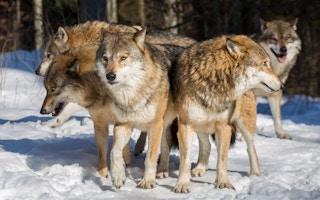Despite a lack of scientific evidence, there has been an assumption made by many governments around the world and even some conservation groups that allowing the legal killing or hunting of recovering populations of large carnivores is a reliable means of decreasing illegal killing, or poaching.
Even the World Conservation Union—IUCN, in its “manifesto for large carnivore conservation in Europe,” proclaims that “Legalised, well regulated hunting of large carnivores at sustainable levels can be a useful tool in responding to conflict, through slowing their increase to socially acceptable levels, engaging local populations in management, increasing their perceived local value, and decreasing illegal killing.”
But Adrian Treves of the University of Wisconsin and Guillaume Chapron of the Swedish University of Agricultural Science, who have just completed a study in Wisconsin and Michigan — two states where the on-again, off-again protected status of wolves between 1995 and 2012 has led to what the scientists characterised as something of a “quasi-experiment” in itself — say that legalised hunting may actually have the exact opposite effect as what’s intended.
Treves and Chapron, who have published the results of their study in the journal Proceedings of the Royal Society B this week, write that theirs is “the first quantitative evaluation of the hypothesis that liberalising culling will reduce poaching and improve population status of an endangered carnivore.” They found that “allowing wolf (Canis lupus) culling was substantially more likely to increase poaching than reduce it.”
The researchers write in the study that the difficulty of obtaining evidence of poaching — poachers, after all, typically hide evidence of their crimes, insofar as possible — has allowed the notion that illegal killing will decline in the presence of legal killing to persist.
On the contrary, according to Treves and Chapron, allowing legal hunting of an endangered species, even as a means of reducing human-wildlife conflict and therefore reducing poaching, appears to actually devalue the life of that species in people’s eyes, leading, ironically, to more poaching.
“
When the government kills a protected species, the perceived value of each individual of that species may decline; so liberalising wolf culling may have sent a negative message about the value of wolves or acceptability of poaching.
Adrian Treves, researcher, University of Wisconsin and Guillaume Chapron, researcher, Swedish University of Agricultural
The study looked at the rate of growth in the wolf population in the two states as an indirect measure of the extent of poaching. The researchers found that the wolf populations’ growth rates declined, from 16 per cent to 12 per cent, when culling was permitted.
The two scientists then used mathematical models to estimate the probability that the growth rate had changed as a function of the state’s culling policies. While Treves and Chapron couldn’t study poaching levels directly, they were able to rule out other explanations for the observed declines in wolf numbers, such as the wolves migrating to neighboring states or natural fluctuations in wolf populations.
In other words, poaching was the only likely explanation for the decrease in wolf population growth, they found. “Although our model does not include poaching as an explicit parameter, poaching was the most parsimonious explanation for observed decrease in wolf population growth rates, because we could rule out alternative plausible biological explanations.”
As further evidence supporting this conclusion, the authors note that their results are consistent with empirical studies that link intentions to poach with culling policy.
A 2013 study in Wisconsin that measured intention to poach wolves, for example, found those intentions rose in parallel with liberalised culling laws, and that those intentions did not go away after legalised killing was allowed.
As the New York Times reported, however, not everyone is convinced by Treves and Chapron’s findings.
Tim Van Deelen, a wildlife ecologist at the University of Wisconsin, said that linking increased killing of wolves by humans to policy changes was “too much of a stretch,” and offered other possible reasons for the slowdown in population growth, such as reduced survival of wolf pups, decreased litter size, disease, and increased territorial battles.
But Treves and Chapron say their results show just how much official policy can shape human attitudes toward wildlife, and that legalized hunting of large carnivores is likely sending the exactly wrong message.
“When the government kills a protected species, the perceived value of each individual of that species may decline; so liberalising wolf culling may have sent a negative message about the value of wolves or acceptability of poaching,” they write in the study. “Our results suggest that granting management flexibility for endangered species to address illegal behaviour may instead promote such behaviour.”
This story is republished with permission from Mongabay.

















